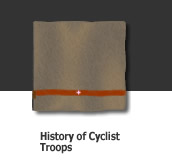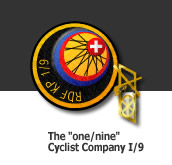Swiss Army and the military cyclists
Emergence and Development
For more than hundred years cyclists have played an active role in the Swiss Army. In no other army of the world they got a comparable importance and in no other country they established themselves as a combat troop persisting until the begining of 3rd millenium.
Their tasks changed in the course of the time. Whether as despatch riders or surveillants, as assaulters or in the defence, they always have succeded to use the bicycle efficiently and purposefully. In the lowlands as well as in the Swiss Alps, on and off road, in severe cold and in the summer heat. As long as there was air in their tires (and otherwise on the rims), the cyclists always found a way. The actual founder of the cyclist troops, Obertsdivisionaer Alphons Pfyffer, leader of the Confederational General staff office, arranged some rides with military reporting cyclist in 1887. One of the main arguments for the use of cyclist formations was at that time to save on cavalry ressources.
For this reason exclusively cavalry troopers got the offer "to change saddles". In addition to lighter uniforms, adapted to the requirements of the soldiers, the armament with a pistol with bayonet should contribute to give the drivers an obvious military character and recognition as regular soldiers.
In the consequence both the bicycle, as well as the equipment were further developed. The troop pool was extended gradually and terms and content of the training was adapted more and more to comparable other branches of service. The Ordonanzrad 05, which was developed around the turn of the last century and rolled out starting from 1904 to the cyclist companies, should remain loudless means of transport of Swiss army for one century, nearly without changes. By the introduction it was equipped with free-wheel, pneumatics (the first pneumatic tires invented by Dunlop in 1887), lantern and a bell. back-pedalling brake and electrical lighting were added many years later. In the meantime the cyclist troops were subordinated to the infantry. From 1949 on they were part of the 'light brigades' and got assigned to the mechanized divisions in 1962. In 1972 the Swiss Army's cavalry, from that the cyclist originally came out, was definitly abolished.
In the course of the 'Armee 95' the integration of the cyclists into the infantry was discussed. Finally they remained with the "yellow ones" (mechanized troops) shaping the term "mechanized and light troops" (MLT). With the army reformation in 1995 the tasks of the cyclists changed. At the end of the ninetynineties es the cyclist troops got their own branch of service badge, which takes them off from the infantrymen by a symbolized spoke wheel below the crossed rifles.
|






